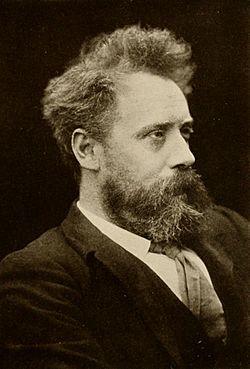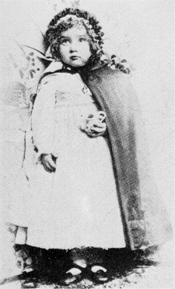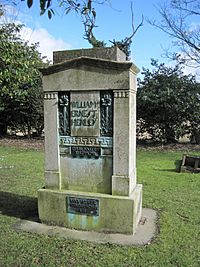William Ernest Henley facts for kids
Quick facts for kids
William Ernest Henley
|
|
|---|---|
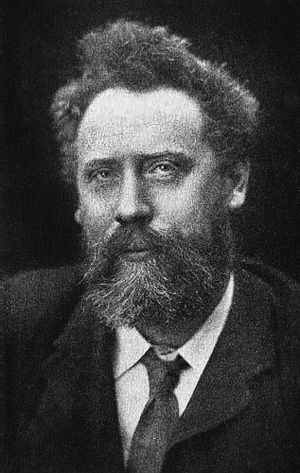 |
|
| Born | 23 August 1849 Gloucester, England |
| Died | 11 July 1903 (aged 53) Woking, England |
| Occupation | Poet, critic, and editor |
| Nationality | English |
| Education | The Crypt School, Gloucester. St Andrews University. |
| Period | c. 1870–1903 |
| Notable works | "Invictus" |
| Spouse | Hannah Johnson Boyle |
| Children | Margaret Henley |
William Ernest Henley (born August 23, 1849 – died July 11, 1903) was an English poet, writer, and editor. He wrote many poems, but he is best known for his powerful poem "Invictus" from 1875. Henley was a well-known person in London's writing world. He had one leg, and some people think he inspired the famous character Long John Silver in Robert Louis Stevenson's book Treasure Island. Also, his young daughter, Margaret Henley, inspired J. M. Barrie to name the heroine Wendy in his play Peter Pan.
Contents
Early Life and School
William Ernest Henley was born in Gloucester, England, on August 23, 1849. His mother, Mary Morgan, was related to the poet Joseph Warton. His father, William, was a bookseller. William was the oldest of six children. His father passed away in 1868.
Henley went to The Crypt School in Gloucester from 1861 to 1867. The school's headmaster, Thomas Edward Brown, was a very smart teacher. Henley admired him greatly, calling him "a man of genius." Henley and Brown stayed friends for life. Even though Henley liked his headmaster, he felt his school was not as good as others.
Later, in 1893, Henley received an honorary degree from the University of St Andrews.
Health Challenges and a Famous Character
When Henley was 12, he got a serious bone disease called tuberculosis. This led to his left leg being removed below the knee in 1868. He often felt a lot of pain because of his illness. However, his younger brother Joseph said that William would "Hop about the room, laughing loudly." He would pretend the pain didn't bother him.
The author Robert Louis Stevenson was a friend of Henley's. Stevenson said that Henley inspired his character Long John Silver in Treasure Island. Stevenson wrote to Henley, "It was the sight of your maimed strength and masterfulness that begot Long John Silver." Stevenson's stepson described Henley as a "great, glowing, massive-shouldered fellow with a big red beard and a crutch." He added that Henley was "jovial, astoundingly clever, and with a laugh that rolled like music."
Henley's illness often kept him from school. In 1867, he passed an important exam. Soon after, he moved to London to become a journalist. For the next eight years, his work was stopped by long stays in hospitals. His right foot also became diseased. Doctors thought he might need another amputation. But Henley sought help from a famous surgeon, Joseph Lister, in Edinburgh. Henley stayed in the hospital for three years (1873–1875). During this time, he wrote poems that were later published as In Hospital. This period also marked the start of a long friendship with Robert Louis Stevenson.
How People Saw Him
People often noticed the big difference between Henley's physical appearance and his sharp mind. His friend Sidney Low said Henley looked like "the great god Pan...with halting foot and flaming shaggy hair."
However, not everyone had the same view. After Henley died, author Wilfrid Scawen Blunt wrote in his diary that Henley had "the bodily horror of the dwarf." He also mentioned Henley's "defiant attitude towards the world."
Family Life
Henley married Hannah (Anna) Johnson Boyle on January 22, 1878. She was from Scotland. In 1891, William and Anna were living in Edinburgh with their two-year-old daughter, Margaret Emma Henley.
Margaret was a sickly child. She became famous because of J. M. Barrie's classic children's story, Peter Pan. Margaret couldn't speak clearly. She called her friend Barrie her "fwendy-wendy." This is how the name "Wendy" was chosen for a girl character in the book. Sadly, Margaret died in 1894 when she was only five years old.
Henley's friendship with Robert Louis Stevenson ended for a while in 1888. Henley thought Stevenson's wife, Fanny, had copied a story from his cousin. They later started writing to each other again after friends helped.
Hospital Poems
Henley and his friends, sometimes called the "Henley Regatta," liked to write in a realistic style. They were against a style called "Decadence." Henley published many poems in collections like In Hospital (written 1873-1875). He is most famous for "Invictus" from 1875. This poem was written while he was in the hospital, fighting his illness. These "hospital poems" showed the idea of the "poet as a patient." They were also early examples of modern poetry, using free verse and showing a person's inner thoughts.
These poems often described what Henley saw around him in the hospital. He wrote about the other patients and their struggles.
His Work as an Editor
After he got better, Henley started working as a journalist and editor. He became a very important voice in late Victorian Britain. As an editor of different magazines, he chose who would write for each issue. He also wrote his own essays, reviews, and poems. He had a big impact on the writing world of his time.
For a short time in 1877 and 1878, Henley edited The London Magazine. He wrote many poems for this magazine without using his name. People at the time called these poems "brilliant."
In 1889, Henley became the editor of the Scots Observer, a journal about arts and news in Edinburgh. In 1891, it moved to London and became the National Observer. Henley edited it until 1893. This paper was very important in the literary world. It published Rudyard Kipling's famous Barrack-Room Ballads.
Death
In 1902, Henley had an accident when he fell from a train. This caused his old tuberculosis to get worse. He died from it on July 11, 1903, at age 53, at his home in Woking, England. His ashes were buried in his daughter's grave in Cockayne Hatley.
Memorial
There is a statue of Henley in the crypt of St Paul's Cathedral in London.
His Legacy
During his life, Henley became quite famous as a poet. His poems were even known in the United States. After he died in 1903, a friend wrote about him, saying he had "an inner well of cheerfulness, and a spontaneous joy of living." This shows that Henley was known for his strong spirit and positive outlook. The loss of his daughter was very sad for him, but it didn't completely take away his joy for life.
While his poetry was almost forgotten for a time, "Invictus" remains very popular. Also, his works are now available online. This means that Henley's important influence on culture and literature from the late-Victorian period is still remembered.
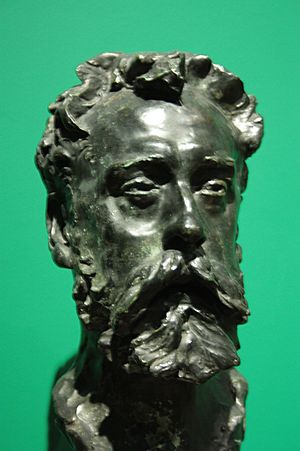
In Art and Popular Culture
- The composer George Butterworth set four of Henley's poems to music in 1912.
- Henley's poem "Pro Rege Nostro" became popular during World War I. It was used to inspire patriotism in Britain. It has a famous line:
What have I done for you, England, my England?
What is there I would not do, England my own?
- This poem has also been made fun of by people who didn't like its strong nationalistic message.
- The poem is mentioned in the title of a short story by D. H. Lawrence and a funny novel by A. G. Macdonell.
- Nelson Mandela recited the poem "Invictus" to other prisoners when he was held at Robben Island. Many believe he used it to show the importance of self-control and strength.
- This event was shown in the Clint Eastwood film Invictus (2009). In the movie, the poem inspires the South African rugby team to win the 1995 Rugby World Cup.
- In her autobiography, I Know Why the Caged Bird Sings, Maya Angelou wrote that she "enjoyed and respected" Henley's works.
- The English playwright Joe Orton used lines from Henley's poem Madame Life's a Piece in Bloom for the title and theme of his play The Ruffian on the Stair.
Madam Life's a piece in bloom
Death goes dogging everywhere:
She's the tenant of the room,
He's the ruffian on the stair.
- Henley's translation of a poem by François Villon was recited by the performer Ricky Jay. A folk band also set it to music in 2020.
His Works
Poetry Collections
- The poems in In Hospital are important because they are some of the earliest free verse poems written in the UK. Henley's most famous poem, "Invictus", was written in 1875. He wrote it to show his strength after his leg was removed due to illness. Henley said the poem's main idea was that "one's decisions and iron will to overcome life's obstacles, defines one's fate."
- In 1888, a collection called Ballades and Rondeaus, Chants Royal, Sestinas, Villanelles, &c… included 30 of Henley's poems. These poems used old French forms.
- In 1892, Henley published another book of poems, first called "The Song of the Sword." It was later renamed London Voluntaries.
- Hawthorn and Lavender, with Other Verses (1901) was a collection of Henley's poems. It included a dedication to his wife. It also had a section called "London Types" with short poems about people like a "Bus-Driver" or a "Barmaid."
- A Song of Speed was his last published poem, released just two months before he died.
Plays
- In 1892, Henley also published three plays he wrote with Stevenson: Beau Austin, Deacon Brodie, and Admiral Guinea. Deacon Brodie was performed in Edinburgh in 1884.
See also
 In Spanish: William Ernest Henley para niños
In Spanish: William Ernest Henley para niños


